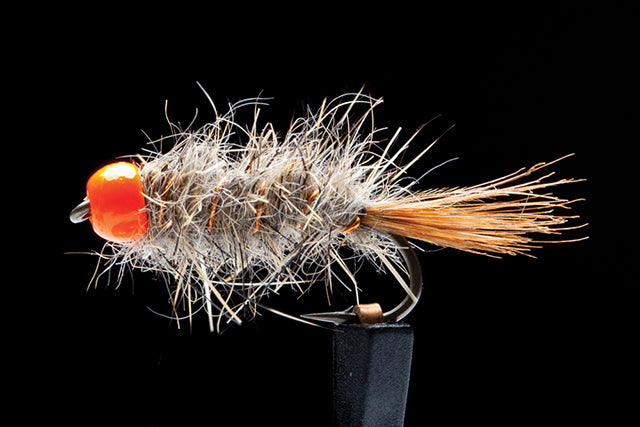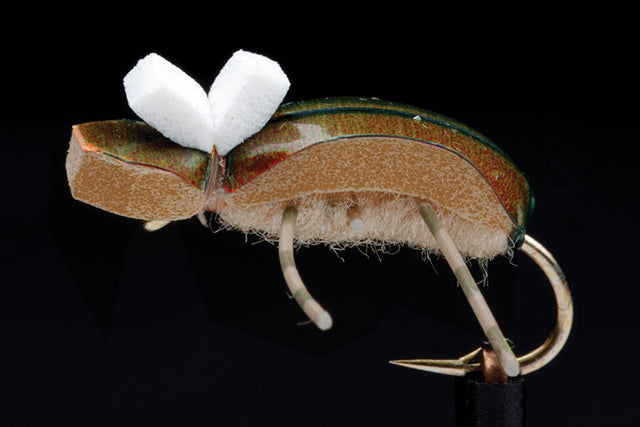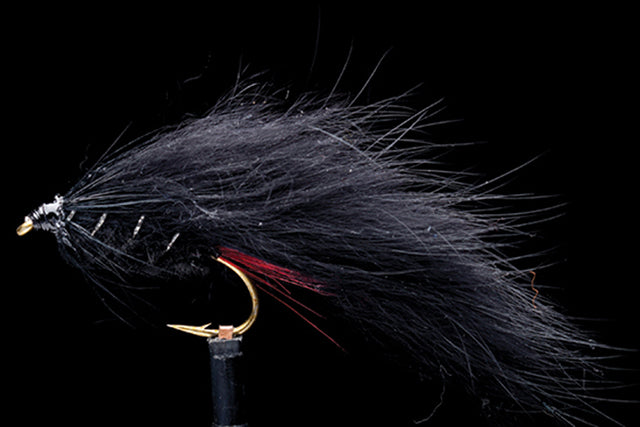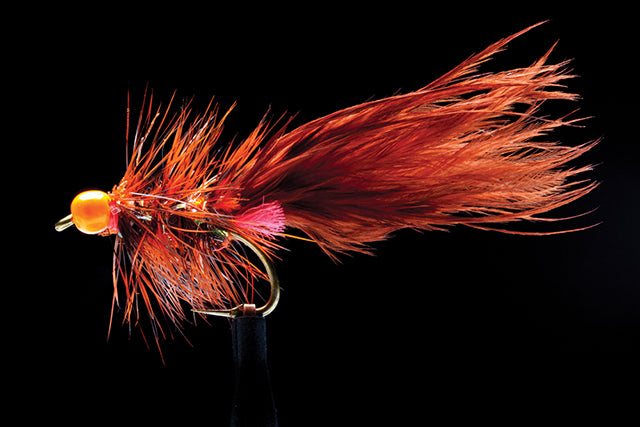The Tongariro River | A Guide To Fly Fishing In Taupo
There's loads written on the Tongariro River (and Taupo fly fishing in general) over the years, tons of books, magazine articles, internet pieces etc...so we're not going to attempt to be completely exhaustive in our guide but rather we're going to share our experiences, try and cut through some of the noise and just filter it down to a quick reference piece to help you hit the water running.
We're always keen on feedback and questions and this is going to be a living, open source document so please get in touch on our FACEBOOK page if you have some thoughts you'd like to add into the mix or questions answered.
MORE FROM THE MANIC GUIDE TO FLY FISHING IN TAUPO:
- PART TWO: The Tauranga Taupo River
- PART THREE: Lake Otamangakau
- PART FOUR: The Hinemaiaia River
- BONUS: Andrew Harding's Ten Taupo Fly Fishing Tips
For part one we'll jump straight into the river that really represents the fishery as a whole, the mighty Tongariro.
THE TONGARIRO RIVER
The iconic Tongariro river is the quintessential fly-fishing river. Combined with its raw beauty and desirable characteristics it just keeps calling you back. This diverse, year-round fishery has it all, offering quality fishing with such great variety, twelve months of the year. The river also accommodates a wide range of fly-fishing techniques which adds a special element and ultimately providing a unique angling experience.
Lake Taupo is New Zealand’s largest lake and would have to be the country’s most productive trout fishery being home to healthy populations of both rainbow and brown trout. This impressive body of water is also the source of the mighty Waikato river which forms via its outlet located near Taupo. But it is the tributaries flowing into the lake that provide great fly fishing, each with their own unique characteristics and range in size from little wee creeks and streams that flow out of the hills to medium sized rivers sourced from the Kaimanawa ranges and then to the largest and most famous river system, the Tongariro river, which drains the Tongariro National park adding great variety to the fly-fishing experience found here.

The Taupo trout fishery needs no introduction and is well known for having some of the best fly fishing found anywhere in the world, it’s a legitimate trout fishing mecca! It's unique in the sense that it's not managed by Fish & Game, rather it's looked after and run by the Department of Conservation, so requires its own licence. The town of Turangi, which is situated on both sides of the Tongariro river, is home to a small population of residents but has a great community feel. For decades now, snow sport lovers have made Turangi their base to access the skiing and boarding on Mt Ruapehu so it can also be classed as a small ski town with benefits from this seasonal activity. However primarily it’s known as the Trout Capital of the World which is a well-earned title for a long time now, and that can only reflect on the quality and diversity of fly fishing found here with the endless productive fishing water available so accessible to town.
Every year thousands of anglers travel from all around the world specially to experience the fly fishing the region has to offer, which would have to be most famous for its fresh run, silver bullet, rainbow trout which make their annual migratory journey from the lake up the many rivers and streams flowing into the lake and can be especially good after a flood. During the months of May through to September this iconic event provides high quality and much sort after fly fishing fun.

In spring, large numbers of trout return to the lake to feed up and regain their condition lost spawning, although a significant number of fish will remain, favouring the river environment to recover. Late in the year, after a period in the lake brown trout start to actively move back into the rivers again, slowly but surely repopulating and occupying the habitat again. By summer they are well established, with the most significant brown trout fisheries being the Tongariro and Waitahanui rivers. This crucial event adds a valuable element of brown trout fishing which provides anglers with the ultimate challenge.
In spring the iconic dry fly season kicks off which sees frequent and often prolific insect hatches right through into the summer months and this provides some of the best dry fly fishing action found anywhere fishing for plentiful rainbow trout, along with a decent chance of catching that big brown. If you haven’t experienced fly fishing in Taupo yet then we recommend you add it to the top of your bucket list right now, this is a must do fly fishing opportunity to immerse yourself in an anglers paradise.

KYLE'S TONGARIRO RIVER INSIDER TIPS
- Look to riverside accommodation, this makes the perfect angling base so you can leave the car behind with a day’s worth of angling water so closely reached by foot.
- To get the best from your indicator keep the size realistic. A budgie sized indicator just makes for hard work whereas a dense medium sized well treated indicator is ideal. Used a fine-toothed pet comb to brush floatant into the indicator.
- Did you know the Tongariro River has its own casting technique? Check out our comprehensive Tongariro Roll Cast how-to.
- For the best start to your fishing day make sure you hit the Delta Coffee Cart by the Bridge Pool early, a pie and cooffe is the go and it's nice to take it easy watching the morning anglers from the bridge. Then for a heart attack lunch head up to Creel Tackle House & Cafe for another coffee and Croque Monsieur. Then finish the day with a number of options. Fancy a curry then a lie down at home? Monsoon has your back. Hit the pub with the locals and watch the rugby at Turangi Tavern, great pub meals. Or pop into Rust for a more intimate atmos, some great tapas and a cheeky crafty
- Looking for a head start on tricks and tips? Andrew Harding has ten great tips for the Tongariro River

TONGARIRO RIVER FLY SHOPS
Check any of these great retailers for top ups of flies and tippet or if you're feeling in the treat yourself mood for a new pair of waders or fly rod. It's mandatory to at least pop in and buy some flies so you can get the good oil on what's been happening on the rivers recently from the local Turangi crew that know.
TONGARIRO RIVER ACCESS OVERVIEW

CLICK THIS LINK FOR THE MAP OF THE TONGARIRO RIVER
LOWER RIVER - BOTTOM OF GRACE RD TO LOG POOL
Environment: Lower gradient, featureless water typically hard to read. Flows out to a delta with deep drop offs.
Features: Willow lined banks, long sweeping bends, gravel bars, gravel and sand riverbed with very few rocks.
Characteristics: Long gravel runs, varying pools, back waters, fallen willow trees in the water and braids.
TOWN POOLS - BAIN POOL TO HYDRO POOL
Environment: Transitioning to more stable water.
Features: More stable cut banks with vegetation, some native forest, boulder river flats, sandy beaches with a sand and boulder riverbed.
Characteristics: Varying runs, connect with the major pools
MIDDLE REACHES - KAMAHI POOL TO RED HUT BRIDGE
Environment: Steeper gradient, with defined water.
Features: Native Bushed lined riverbanks, boulder river flats, sand and boulder riverbed.
Characteristics: Consists of large varying pools along with fast runs and pocket water.
UPPER REACHES - WADDELLS POOL TO FENCE POOL (WINTER) OR RANGIPO DAM (SUMMER)
Environment: Steep gradient, rugged, picturesque and more remote location
Features: Native bush lined banks, boulder river flats, sand and boulder riverbed.
Characteristics: Consists of large, varying pools along with fast runs and pocket water.
HOW TO FLY FISH THE TONGARIRO RIVER

Trout can be found throughout the river system which provides ample productive fishing water, however the sheer size and volume of water can be a little bit intimidating initially, making it hard to know where to start. Most pools hold good populations of rainbow and brown trout all year round which makes them a reliable option and a good place to start. Sight fishing is on offer and a good option particularly for browns which are easily spotted, but this can be limited and only accounts for a small part of the overall fishing opportunities.
Trout spread throughout the pool’s length and use the habitat on offer so this requires a lot of work to cover all the aspects of each pool, but this is not always needed and isn't an overly productive way to use your time. Initially, focus on the key productive fish holding lies being the tail, the body and the head of the pool. Typically speaking, at first light fish will hold in the soft edge water very close to shore as that has been well rested overnight and undisturbed by anglers. As the day grows older and brighter, along with receiving constant angling attention and all sorts of egg patterns, fish tend be pushed out finding cover from the deeper or heavier water of the middle and far side of the pool along with the fast broken water at the head so it pays to be mindful of this with your approach.
The rivers other important features include various runs, pocket water and the odd braid. These also hold good fish numbers and are far less pressured but are not as easily found, requiring a bit of thought along with leg work to get to but well worth the effort. Naturally these can be more friendly to fish because of their more manageable size and favourable characteristics and provides a great alternative to the demands of big pools. When nymphing to maximise your efforts it is very important to work at achieving a drag free drift as much as possible so that your flies are sinking effectively down to where the fish are. As a result of the varying flows, speed, currents, densities, and depth of water the river demands a lot of effective mending to achieve the right drift and this is the key to angling success on the Tongariro river. Here's a great place to stay in touch with the rainfall and Tongariro river flows so you can plan your trip around what's happening on the water. Wading the Tongariro also deserves respect so make sure you're up to speed with some wading safety tactics and have your winter clothing layering system sorted.
POPULAR TAUPO FLY FISHING METHODS
A valuable attribute of the river is how well it is suited to all fly-fishing techniques which can be used effectively all year round. Whether you prefer fishing upstream or down stream, or both, there is plenty of space and opportunity for anglers to find themselves a spot and get into some fish.
1) NYMPHING

Upstream nymphing on the Tongariro river is a reliable and productive method, great way to cover all aspects of the river well and imitate the food source easily. An approach with an upstream cast or slightly across works well on the rivers less demanding and more forgiving water, found at the heads of pools, runs, pocket water and braids.
Given the size of some of the water you could be forgiven for thinking it's all about blasting big casts to the other bank but in reality the key is to be proficient at mending for a drag free drift no matter where your flies land. Staying in touch with the line is also very important, and by keeping any excess line on the water below the rod tip to a minimum you will ensure a positive strike and hook up when the indicator does eventually go under. For best results, the distance between indicator and flies will need to be adjusted regularly to suit water depth and speed. A double nymph rig is ideal and a very effective way to fish. Match the best weighted fly to the situation, where needed change out the fly weight to suit water depth and speed. A variety of nymphs varying in weight, rather than pattern, are essential for covering all basis. Make sure to read this piece on how to cast heavy flies, you'll thank us for it later.
The big pools present a few more challenges due to greater depths, varying currents, and density of the water which all require a slightly different approach for best results. Attach the strike indicator to the end of fly line, and a heavier bomb style fly is needed to beat the heavy currents in order to reach the fish. Approach upstream typically casting up and across starting with covering the closest water and slowly working your drifts over to the far bank. Concentrate on setting up a good drift well ahead of your intended as target this gives plenty of time for the flies to sink down into the zone. A tell tail sign for achieving an effective drift, is when the strike indicator is standing upright as this indicates the leader has straightened out completely, and when the flies are on the bottom the indicator will gently bob up and down, this is perfect and ultimately what you should try to achieve with each and every drift you make.
2) DRY FLY
Spring through Autumn fishing a dry fly on the Tongariro is ideal for sight fishing, prospecting, and super fun for the evening rise. With hatches of Mayflies, Caddis, Stoneflies, and terrestrial insects like Beetle’s, Cicadas, and Passion Vine Hoppers there is usally always something happening on top. Cast to sighted fish with a pattern to suit or cover likely water with a big floaty terrestrial. Dead drifting ans skating flies is a reliable option when fishing caddis hatches, casting across and letting the line swing can be deadly effective. When dead drifting terrestrial’s, movement can introduced by short strips of the line this proves to be very affective on slow moving water. Even in winter you will get the odd fish coming up in the evening so never count the dry fly out.
3) WET LINING / SWINGING FLIES

Wet lining on the Tongariro river is the most traditional technique used here well before nymphs were around. It's an excellent method for covering most water and very effective in winter, or with coloured water, and with brown trout at night.
The best approach is to work your way downstream from the head of the pool and covering water by fishing across and down, meaning, the cast is made across river and fished downstream. Position yourself in the river, ideally no more than thigh deep and facing the intended target. To achieve the best swing and presentation of the flies, cast across river and then a u-shaped belly will form naturally in the current below the rod tip downstream of you. Make sure you keep in contact with line throughout the swing, and hey presto, you're wet lining!
Once the fly line has straightened out directly below its time to strip the line in and repeat. If a piece of water demands your fly to sink immediately to reach a specific tricky lie, this can be achieved by introducing slack line into the system with a simple mend or just slipping extra line on the water.
4) SINGLE HANDED SPEY
Single handed spey has experienced a recent growth in popularity on the Tongariro river as it covers most water and is great for tight spaces with no overhead back cast. Swinging streamers is very effective in winter for lake run spawning fish who are less inclined to feed but will strike out of agression. Using the same across and down drift method used for wet lining, the cast is best performed from the river bank or ankle deep water, any deeper than this will have a negative impact on the ability to execute the cast well.
Follow this link to learn more about the in's and out's of Single Handed Spey.
5) TWO HANDED OR SPEY FISHING

While there has always been a small, dark underbelly of two handed fisherman on the Tongariro river it's now evolved into a fast-growing and very popular technique. It's a great way to cover big water and the hard to reach and productive lies of the far bank efficiently and with ease and well suited to winter fishing. It's also helping spread the anglers out with less pressure on everyone nymphing and pools now being better shared by up and down streamers alike.
As with wet lining and single handed spey the drift is fished across and down by systematically swinging streamer flies through the likely holding water. Fish a sink tip with the sink rate best suited for the water depth, density and speed. These will vary a lot throughout a day on the Tongariro so it's best to carry a few different grain weights and be ready to change out as needed. If the water demands the fly to be fished even deeper then slack line can be introduced achieve this. An upstream mend straight after the line has landed on the water will help to achieve this or, reset the drift after the line has landed on the water by sliding the line back a few metres or so. You can do this by raising the rod high and bringing it back towards you, then immediately drop the rod back to the fishing position.
As with any style of fly fishing, adjusting flies and leaders along with fly choice also has a positive effect when things are slow.
New to double handers and want to learn more? Click here for an Intro To Spey article by Rene Vaz.
6) CZECH / EURO NYMPHING

Euro nymphing the Tongariro River is relatively new for most anglers but has proven itself to be a deadly game changer and productive all year round as it suits most water and is great for covering the fast flowing and broken water. Perfect for winter spawning fish.
Using an upstream approach, concentrate on the heads of pools, fast runs, pockets and broken water places that demand the flies to be on the bottom in a short space of time. These zones are ideally suited to this technique. Systematically covering water by working upstream is ideal and it pays to go heavy when targeting spawning fish with czech nymph techniques.
THE GEAR TO FISH THE TONGARIRO RIVER
When it comes to gear there's plenty of different ways to skin a cat, so to speak. So rather than drill down into various models and brands for each of the methods we're going to run through below we've supplied some quick links to what we like to use instead.
FLY RODS: Scott, Primal & Airflo
FLY REELS: Waterworks Lamson, Ross, & Abel
FLY LINES: Airflo
LEADER & TIPPET: Trouthunter & Airflo
INDICATORS: Loon Outdoors
FLIES: Manic Fly Collection
NYMPHING
Fly Rod: Medium Fast / Fast 9' #6 or #7, or 9'6" #6
Reel: Large arbor 5/6 or 7/8
Fly Line: Airflo SuperFlo Ridge 2.0 Power Taper #6 or #7
Indicator: Yarn medium sized and well treated, attached to the loop at the end of fly line- (more often used during the winter months). Alternatively, an amount of yarn can be positioned further down the leader with a simple half hitch or a piece of tube which can be adjusted to suit water depth and situation.
Leader: Tapered mono, length 14ft-15ft (including tippet) from the end of the fly line to the first fly.
Tippet: 6-8lb fluorocarbon or monofilament nylon.
Double Nymph Rig:
- Tie on the weighted fly first to the end of the leader.
- Tie a section of tippet 300mm long to the curve of the hook.
- Tie the unweighted nymph to the remaining end of tippet.
Flies: Depending on the time of year, you will need a variety of different nymphs, unweighted and weighted to cover off the different situations that present themselves, egg patterns are great for Autumn and Winter when teamed up with a Stonefly or something else that is big a heavy when the flows are cranking. As a starting point, here are my suggestions from the Manic Fly Collection:

Death Metal Pheasant Tail #10-#14

Simon's Ugly Hare & Copper #10-#12

Jig PT # 10-#12

Pheasant Tail Flashback #14-16

Hotspot Czech Nymph Caddis Green #12-#14

OTB Hare & Copper #10-#16

Otter's Egg Apricot #12-#14
DRY FLY
Fly Rod: Medium Fast / Fast 9' #5-#6
Reel: Large arbor 5/6
Fly Line: Airflo SuperFlo Ridge 2.0 Universal Taper #5 or #6
Leader: Tapered mono 9ft 3x
Tippet: Fluoro 4lb-7lb
Flies: Match the hatch is required at times but is not always crucial. Here's a good selection to cover most bases:

Parachute Adams #12

Quill Klink #14

Elk Hair Caddis #12

Foam Brown Beetle #12

Para Improved Humpy Blowfly #12

Kiwi Cicada

X Stimulator Royal #8

Rene’s Lace Moth #16
WET LINING
Fly Rod: Fast Action 9' or 9’6 “#6 or 9' #7
Reel: Large arbor 5/6 or 7/8
Fly Line: Airflo Streamer Max Integrated Shooting head WF6/7 sink rate 5-7 inches per second. But also check this article to learn which sinking line might suit you best.
Leader: Tapered monofilament 9ft 12lb
Flies: Woolly bugger and rabbit variants are the order of the day here, and at night go dark or lumo to spark some interest.

BH Woolly Bugger Olive

BH Woolly Bugger Black

Classic Rabbit Yellow

Classic Rabbit Black

Lumo Bugger
SINGLE HAND SPEY
Fly Rod: Fast Action 9' or 9’6 “#6
Reel: Large arbor fly 5/6
Fly line: Airflo Scout Skagit Head 240 grain, combined with 30lb mono running line.
Sink tips: Airflo Flo Tips T7-T14 will cover most basis. Airflo polyleaders are also very useful to have onhand.
Leader: Generally a length of 6ft which can be adjusted to suit conditions. Consists of a 200mm butt section of 20lb mono with a Perfection Loop tied at one end with a tippet ring tied to the other.
Tippet: Fluorocarbon 10-12lb.
Rig:
- Attach leader butt section with loop to loop connection.
- Attach fluorocarbon tippet section to the tippet ring.
- Attach fly using a lefty’s loop knot.
Flies:

FOB Olive Woolly Bugger #8

Belindas Bitch Slap Olive / Blue

Keller’s She-Demon Black

Yoshi Bugger Brown #8

Classic Rabbit Orange #6

Otter's Egg Tangerine #12

BH Woolly Bugger Hustler #8
SPEY / TWO HANDERS
Fly Rod: 11' #4 or 11' #6
Reel: Large arbor 5/6 or 7/8
Line: Airflo Skagit Scout 300gr #4 & 420gr #6, floating running line 20lb.
Sinking Tips: Airflo Flo Tips T7-T14 covers most situations.
Leader: Length 200mm of 20lb mono with
ABOUT THE AUTHOR:
Kyle Adams is what's known as a fly fishing one percenter. He's a super talented angler, amazing fly tier, and great guy to boot. If you see him on the river make sure to say hi, chances are you will walk away after a great conversation and having learned something very cool.

